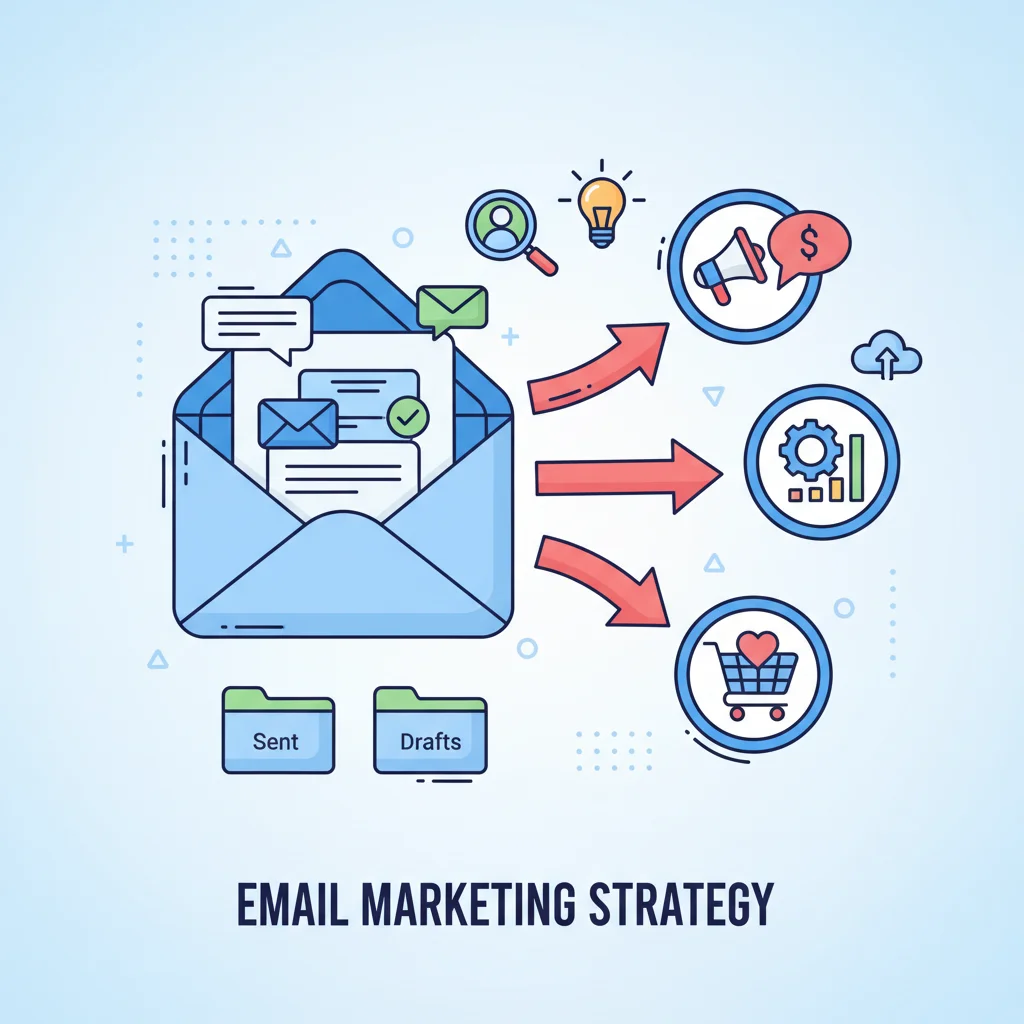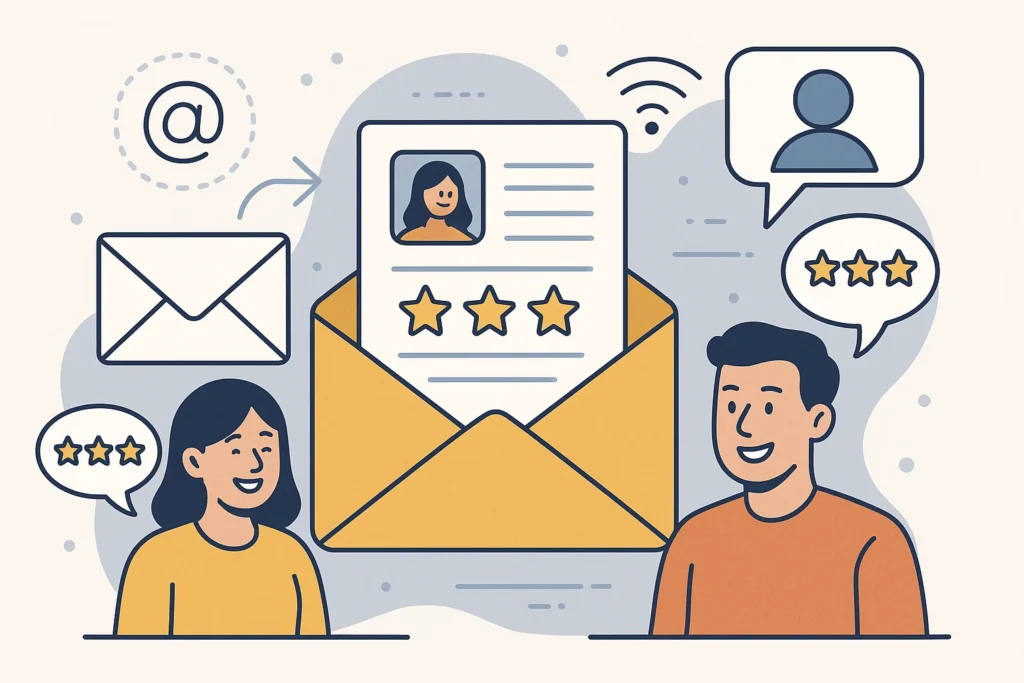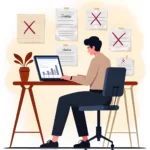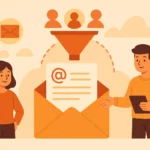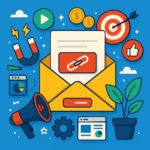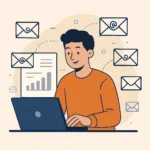Now Reading: 15 Email Marketing Design Best Practices That Convert
-
01
15 Email Marketing Design Best Practices That Convert
15 Email Marketing Design Best Practices That Convert
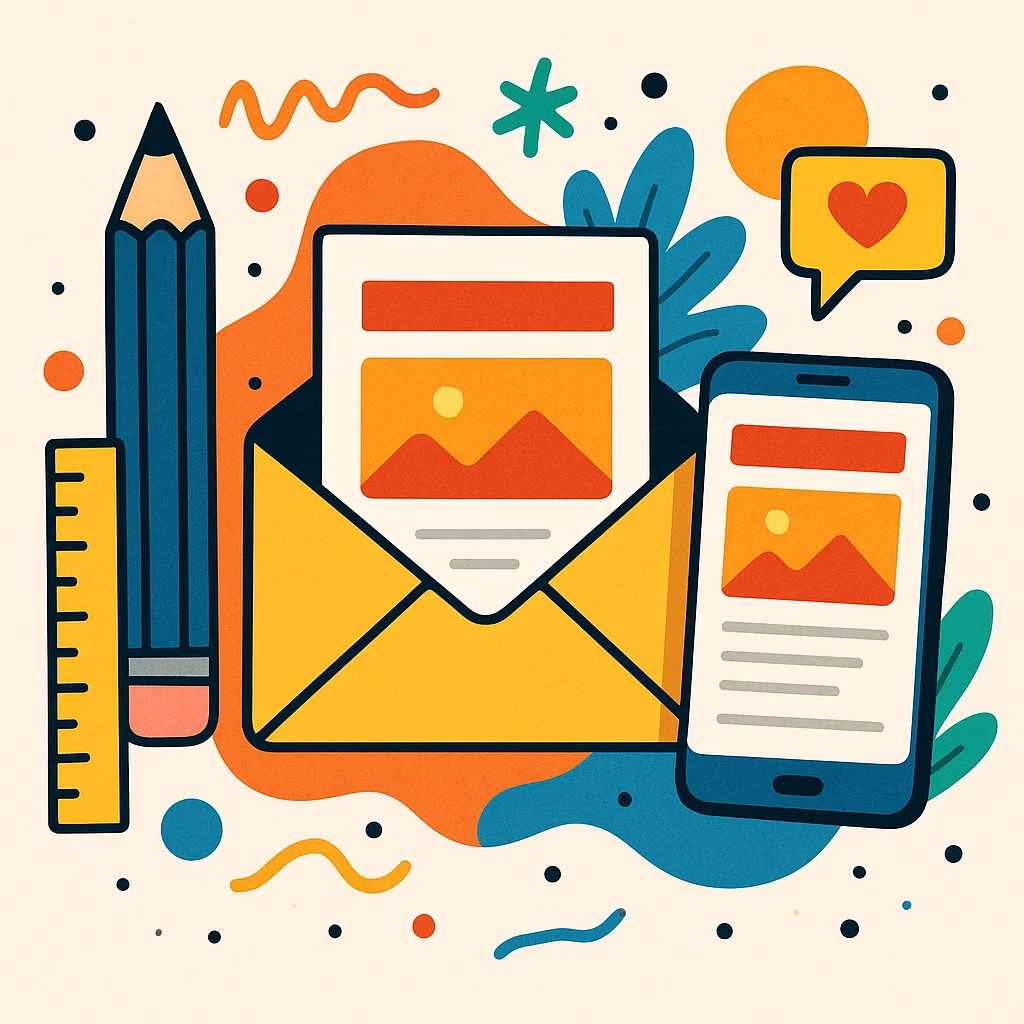
Are your email campaigns falling flat? You’ve spent hours crafting the perfect message, only to see dismal open rates and even worse click-throughs. The problem might not be your offer – it could be your design. Mastering email marketing design best practices isn’t just nice to have; it’s essential for survival in today’s crowded inboxes.
Key Takeaways
What are the best practices for email marketing design? Here’s what you need to know:
- Create a master template with your brand elements for consistency
- Craft compelling subject lines and preview text that grab attention
- Design with mobile-first principles (single-column layouts work best)
- Balance text and visuals for optimal loading and engagement
- Use clear, action-oriented CTAs that stand out
- Maintain consistent branding throughout your emails
- Structure content in an F-pattern for natural eye movement
- Optimize for both light and dark mode viewing
- Incorporate storytelling elements to engage readers
- Use personalization to make emails feel relevant
- Ensure your design is accessible to all users
- Keep headers simple and impactful
- Use appropriate keywords in subject lines and content
- Create a scannable layout with visual hierarchy
- Include a proper email footer with required information
Master Templates: Your Email Design Foundation
Let’s start with something that’ll save you tons of time while making your emails look way more professional. Creating a master template is like having a secret weapon in your email marketing arsenal.
I can’t stress this enough: begin with a master template for all your email campaigns. This isn’t just about convenience-it’s about creating a consistent experience for your subscribers.
When you use a master template, you’re ensuring:
- Consistent branding across all communications
- Huge time savings on design for each campaign
- Professional appearance that builds trust
Your master template should include your logo, brand colors, standard fonts, and footer information. Think of it as the canvas you’ll paint on for each specific campaign.
Pro tip: Create multiple master templates for different types of emails-welcome sequences, promotional offers, newsletters, etc. This gives you flexibility while maintaining that crucial consistency.
One of my clients saved approximately 5 hours per week just by implementing a proper template system for their email marketing. That’s time they could spend on strategy instead of fiddling with design elements!
Attention-Grabbing Subject Lines And Preview Text
You could create the most beautiful email in the world, but if nobody opens it… well, you know how that story ends. That’s why crafting compelling subject lines and preview text is absolutely critical to your email marketing design best practices.
Your subject line is like the headline on a newspaper-it either pulls people in or pushes them away. Here’s how to make yours irresistible:
- Keep it under 50 characters (many mobile devices cut off longer ones)
- Create a sense of urgency or curiosity
- Use personalization when appropriate
- Avoid ALL CAPS and excessive punctuation (hello, spam folder!)
The preview text is your subject line’s trusty sidekick-it provides additional context and can be the tipping point for someone deciding whether to open your email.
For example, instead of:
“May Newsletter” (subject line) + “Having trouble viewing this email? Click here to…” (default preview text)
Try:
“3 Design Secrets We Just Discovered” (subject line) + “These little-known techniques boosted our client’s conversions by 27% last month…” (intentional preview text)
See the difference? The second example gives the reader a compelling reason to open the email.
Remember to incorporate relevant keywords in your subject lines-not just for potential SEO benefits, but because they signal relevance to your readers. Words like “exclusive,” “new,” “save,” and “limited time” have been shown to boost open rates when used appropriately.
Useful Articles:
Mobile-First Email Design Principles
Let me be real with you-if your emails don’t look good on mobile, you’re basically throwing money away. With over 60% of email opens happening on mobile devices, designing for the small screen isn’t optional anymore.
Here’s how to nail mobile-first email design:
Single-Column Layouts Win Every Time
I’ve tested countless email designs, and single-column layouts consistently outperform multi-column designs on mobile. They’re:
- Easier to read without zooming
- Less likely to break on different devices
- More straightforward to navigate with a thumb
When you’re tempted to get fancy with multiple columns, remember that simplicity almost always wins in email design.
Size Matters (For Buttons And Text)
Have you ever tried to tap a tiny button on your phone and ended up hitting something else? Super annoying, right? Don’t do that to your subscribers.
Make your buttons at least 44×44 pixels (Apple’s recommended minimum touch target size). For text, stick to a minimum of 16px for body copy and 22px for headlines.
I once increased a client’s click-through rate by 23% just by making their CTA buttons bigger and more tappable. Sometimes the smallest changes make the biggest difference!
Test On Actual Devices
Email preview tools are great, but nothing beats seeing how your design looks on actual devices. Before sending to your full list, send test emails to yourself and view them on different phones and tablets.
Pay special attention to:
- How images render
- Whether text is readable without zooming
- If CTAs are easily tappable
- How quickly the email loads
Remember that mobile users are often on the go with spotty connections, so optimizing image sizes for faster loading is crucial.
Balancing Text And Visuals
Finding the perfect balance between text and visuals in your emails is kinda like making the perfect sandwich-too much of either ingredient, and the whole thing falls apart.
The 60/40 Rule
I generally aim for a 60/40 split between text and images. This ratio:
- Helps emails load quickly
- Reduces the chance of triggering spam filters
- Ensures your message gets across even if images don’t load
Some email clients block images by default, so your email should make sense even without them. Always use alt text for your images so subscribers know what they’re missing if images are blocked.
Strategic Image Placement
Place your most impactful image at the top of your email, but make sure it doesn’t push your key message below the fold. Studies show you have about 8 seconds to capture attention, so that first screenful of content is prime real estate.
For product-focused emails, high-quality product images are non-negotiable. But don’t just show the product-show it in context or in use. This helps subscribers visualize the benefits.
Visual Hierarchy Through Contrast
Use contrast to guide the eye through your email. This could be:
- Size contrast (larger elements appear more important)
- Color contrast (brighter colors draw attention)
- White space (elements with more space around them stand out)
I recently helped a client redesign their monthly newsletter by simply adding more white space around their main CTA. The result? A 17% increase in click-throughs. Sometimes less really is more!
Compelling CTAs That Convert
Your call-to-action is where the rubber meets the road in email marketing. All the beautiful design in the world won’t help if your CTAs don’t inspire action.
Be Specific And Action-Oriented
Generic CTAs like “Click Here” or “Learn More” are missed opportunities. Instead, use specific, action-oriented language that tells subscribers exactly what they’ll get:
- “Reserve Your Seat Now” (instead of “Sign Up”)
- “Get My Free Template” (instead of “Download”)
- “See Today’s Deals” (instead of “Click Here”)
The more specific your CTA, the better your subscribers can anticipate what happens next-and that reduces friction.
Strategic CTA Placement
Place your primary CTA where it makes the most sense in the user journey-usually after you’ve established value and created desire. For longer emails, don’t be afraid to repeat your CTA 2-3 times, especially if subscribers need to scroll.
A good rule of thumb: your main CTA should be visible without scrolling on most devices.
Design That Stands Out
Your CTA should be the most visually prominent element in your email. Use:
- Contrasting colors that align with your brand
- Plenty of white space around the button
- Button shapes rather than text links for primary CTAs
I’ve found that buttons with slightly rounded corners tend to perform better than perfectly square or extremely rounded buttons. Little details matter!
Consistent Branding Elements
Brand consistency isn’t just about slapping your logo on everything-it’s about creating a cohesive experience that builds recognition and trust over time.
Beyond The Logo
Yes, include your logo (typically in the header), but consistent branding goes much further:
- Use your brand’s color palette consistently
- Stick to your brand fonts (or close web-safe alternatives)
- Maintain a consistent voice and tone
- Use similar imagery styles across campaigns
When subscribers can instantly recognize your emails without even seeing your name, you’ve achieved brand consistency gold.
The Power Of Visual Signatures
Develop visual “signatures” that become associated with your brand. This could be:
- A distinctive header style
- A particular way of presenting images
- A recognizable sign-off in your footer
- Consistent use of certain design elements
One of my clients uses a unique hand-drawn underline style for all their email headings. It’s become so associated with their brand that subscribers immediately recognize their emails.
Consistency Across Channels
Your email design shouldn’t exist in a vacuum. Create visual consistency between your:
- Emails
- Website
- Social media
- Advertising
When a subscriber clicks from your email to your website, the transition should feel seamless, not jarring.
F-Pattern Structure For Natural Reading
Understanding how people actually read emails can dramatically improve your design effectiveness. The F-pattern is one of the most common reading patterns online, and designing with this in mind can boost engagement.
What Is The F-Pattern?
The F-pattern describes how people typically scan content:
- They read across the top (forming the top bar of the F)
- Then move down and read across again (forming the middle bar)
- Finally, they scan down the left side (forming the stem of the F)
This means your most important content should be positioned along this F-shape.
Designing For The F-Pattern
Here’s how to optimize your emails for this natural reading pattern:
- Put your most crucial information in the first two paragraphs
- Use subheadings that start with information-carrying words
- Place important elements along the left side of your email
- Use bullet points to draw the eye down the page
I redesigned a client’s product announcement email to follow the F-pattern more closely, and their engagement metrics jumped by 22%. People appreciate designs that work with their natural behavior, not against it.
Breaking The Pattern When Needed
Sometimes you’ll want to intentionally break the F-pattern to highlight something important. You can do this with:
- A contrasting background color
- An unexpected image placement
- Animation (use sparingly!)
- Directional cues like arrows
Just don’t overdo it-breaking the pattern works because it’s unexpected. If everything tries to stand out, nothing will.
Useful Articles:
Dark Mode Optimization
Dark mode has gone mainstream, and ignoring it in your email design is a quick way to alienate a growing segment of your audience. Here’s how to make sure your emails look great no matter which mode your subscribers prefer.
The Dark Mode Challenge
When an email is viewed in dark mode, email clients often invert colors automatically, which can wreak havoc on your carefully designed emails. Common issues include:
- Logos with transparent backgrounds becoming invisible
- Light text on dark backgrounds becoming unreadable when inverted
- Colors appearing different than intended
- Images looking washed out or too bright
Design Techniques For Dark Mode Compatibility
To ensure your emails look good in both light and dark modes:
- Avoid transparent backgrounds for logos and key images
- Use PNG format with solid backgrounds for critical graphics
- Test how your brand colors appear when inverted
- Consider using dark mode specific versions of your logo
One technique I’ve found effective is to add a thin white border around dark images. This makes them pop against dark backgrounds without affecting how they look in light mode.
Testing Is Non-Negotiable
You absolutely must test your emails in dark mode before sending. Check them on:
- iOS Mail (very common and handles dark mode uniquely)
- Gmail app (both Android and iOS)
- Outlook (desktop and mobile)
I use a combination of actual devices and email testing platforms like Litmus or Email on Acid to ensure dark mode compatibility.
Storytelling In Email Design
Humans are wired for stories-they capture attention, evoke emotion, and are more memorable than facts alone. Incorporating storytelling elements into your email design can transform ordinary campaigns into engaging experiences.
Visual Storytelling Techniques
Your email design can tell a story even before people read a word:
- Use images that show progression or transformation
- Create a visual journey with directional cues
- Use color psychology to evoke specific emotions
- Incorporate characters or scenarios your audience can relate to
A client in the fitness industry increased their click-through rates by 35% by redesigning their emails to show a visual “before and after” story rather than just listing product features.
Interactive Storytelling Elements
Take storytelling to the next level with interactive elements:
- “Choose your own adventure” style emails with multiple paths
- Animated GIFs that reveal information progressively
- Scrolling effects that unveil a story as readers move through the email
- Quizzes or polls that engage readers in the narrative
Just remember that not all email clients support advanced interactivity, so always have a fallback that still communicates your core message.
Emotional Connection Through Design
Design elements can strengthen the emotional impact of your story:
- Use fonts that match the emotion you want to evoke
- Choose images featuring human faces to create connection
- Use color to reinforce emotional themes
- Create contrast between “problem” and “solution” sections
I helped a non-profit increase donations by 28% by redesigning their appeal emails to tell a visual story that created an emotional journey, rather than just stating facts about their cause.
Personalization Beyond {{First_Name}}
Personalization in email design goes way beyond just inserting someone’s name. True personalization creates the feeling that an email was created specifically for each recipient.
Dynamic Content Blocks
One of the most powerful personalization techniques is using dynamic content blocks that change based on subscriber data:
- Product recommendations based on past purchases
- Location-specific imagery or offers
- Content tailored to industry or job role
- Different visuals based on demographic information
I’ve seen conversion rates increase by up to 40% when emails include dynamically generated product recommendations compared to generic product highlights.
Visual Personalization
Consider these visual personalization techniques:
- Show products in the recipient’s favorite color
- Include maps or location-specific imagery
- Use industry-specific illustrations or photos
- Adjust the overall design aesthetic based on age demographics
A retail client saw a 23% increase in click-throughs when they started showing products in the color categories each customer had previously browsed.
Behavioral Design Adaptation
Design emails differently based on subscriber behavior:
- More detailed designs for highly engaged subscribers
- Simpler, more direct designs for inactive subscribers
- Different CTAs based on where people are in the customer journey
- Varied content depth based on past engagement patterns
Remember that personalization should enhance the user experience, not create a “creepy” feeling that you know too much about them. Always balance personalization with respect for privacy.
Accessibility In Email Design
Creating accessible emails isn’t just the right thing to do-it ensures your messages reach the widest possible audience. Plus, many accessibility best practices improve the experience for everyone.
Color And Contrast Considerations
Poor color choices can make your emails unreadable for many people:
- Maintain a contrast ratio of at least 4.5:1 between text and background
- Don’t rely on color alone to convey information
- Avoid problematic color combinations (like red/green) that are difficult for colorblind users
- Use solid backgrounds behind text rather than busy patterns
I once helped a client redesign their emails to improve color contrast, and they saw a 12% increase in overall engagement-proving that accessible design benefits everyone.
Text And Structure Best Practices
Make your emails readable for people using screen readers:
- Use proper heading structure (H1, H2, H3) in a logical hierarchy
- Include descriptive alt text for all images
- Create a logical reading order in your HTML
- Use actual text rather than text embedded in images
For longer emails, include a table of contents at the top with anchor links to different sections. This helps everyone navigate more easily, not just those with disabilities.
Actionable Elements
Ensure everyone can interact with your emails:
- Make buttons large enough (minimum 44×44 pixels)
- Ensure links have descriptive text (not just “click here”)
- Add appropriate spacing between clickable elements
- Consider adding keyboard accessibility for interactive elements
Testing your emails with screen readers can be eye-opening. I do this regularly and often catch issues that would have made content inaccessible to many subscribers.
Simple, Impactful Headers
Your email header is prime real estate-it’s the first thing subscribers see and sets the tone for everything that follows. Keep it simple but impactful for best results.
Essential Header Elements
An effective email header typically includes:
- Your logo (linked to your website)
- A navigation menu (optional and should be minimal)
- The current date or issue number (for newsletters)
- A concise tagline or value proposition
Anything more risks cluttering this critical space and pushing your main content further down.
Header Design Best Practices
Follow these guidelines for header design:
- Keep the height reasonable (under 100px is generally good)
- Ensure it’s responsive and looks good on mobile
- Use consistent positioning across all emails
- Consider a transparent or minimal background
I’ve found that headers with clean, minimal designs generally outperform busy, complex headers. They load faster and don’t distract from your main message.
Strategic Use Of Header Space
Some clever ways to maximize your header:
- Include a secondary message or announcement banner
- Add a countdown timer for time-sensitive offers
- Incorporate seasonal elements to keep the design fresh
- Use the space to highlight your unique selling proposition
A travel client of mine uses their header space to showcase a stunning destination image that changes with each email-it immediately sets the mood and draws readers in.
Useful Articles:
Strategic Keyword Usage
Using the right keywords in your emails isn’t just for SEO-it helps ensure your message resonates with subscribers and aligns with what they’re interested in.
Keyword Research For Emails
Before designing your emails, research keywords that:
- Match your subscribers’ interests and needs
- Align with your campaign goals
- Reflect current trends in your industry
- Connect to your overall content strategy
Tools like Google Keyword Planner can help, but also pay attention to the language your customers use when interacting with your brand.
Placement In Email Design
Strategically incorporate keywords in:
- Subject lines and preview text
- Headers and subheaders
- Button text and CTAs
- Alt text for images
The key is natural integration-forced keyword stuffing will make your emails feel robotic and inauthentic.
Keyword-Rich UTM Parameters
When linking from emails to your website, use keyword-rich UTM parameters to:
- Track which keywords drive the most engagement
- Gather data on which topics resonate with your audience
- Refine your keyword strategy over time
- Connect email performance to overall marketing goals
I’ve helped clients increase their email marketing ROI by up to 32% by aligning their email keywords with their broader content strategy and carefully tracking performance.
Scannable Layouts With Visual Hierarchy
Let’s face it-most people don’t read emails word for word. They scan. Your design should embrace this reality and make scanning as effective as possible.
Creating Clear Visual Hierarchy
Visual hierarchy guides readers through your content in order of importance:
- Use size to indicate importance (larger = more important)
- Position critical elements toward the top
- Use color and contrast to highlight key information
- Create depth with shadows and layering effects
Every email should have a clear visual path that leads ultimately to your primary CTA.
Scannable Content Techniques
Make your content easy to scan with:
- Short paragraphs (3-4 lines maximum)
- Bulleted or numbered lists
- Bold text for key points
- Subheadings that summarize content sections
I redesigned a client’s monthly newsletter using these principles, and their average time spent reading increased by 45%-proving that when content is easier to scan, people actually engage with it more deeply.
White Space As A Design Element
Don’t underestimate the power of white space (empty space) in creating scannable layouts:
- Use generous margins around important elements
- Add breathing room between sections
- Allow text to have sufficient line spacing
- Frame CTAs with white space to make them stand out
White space isn’t wasted space-it’s an essential design element that improves readability and focus.
Proper Email Footer Design
The footer might seem like an afterthought, but it serves crucial functions in your email design. A well-designed footer builds trust and provides necessary information.
Legal Requirements
Every email footer should include:
- Your physical address
- Unsubscribe option (that actually works!)
- Privacy policy link
- Clear identification of the sender
These aren’t just good practices-many are required by laws like CAN-SPAM and GDPR.
Trust-Building Elements
Beyond legal requirements, consider adding:
- Social media links
- Contact information
- Copyright notice
- Security badges or certifications
These elements help establish credibility and give subscribers multiple ways to connect with your brand.
Footer Design Best Practices
For effective footer design:
- Use a different background color to visually separate it from main content
- Keep the design consistent across all emails
- Ensure all links are working and easily clickable
- Make text readable (avoid tiny font sizes)
I’ve found that clean, organized footers with clear sections perform better than cluttered, text-heavy ones. Group similar information together and use subtle dividers for clarity.
Email marketing design best practices aren’t just about making pretty emails-they’re about creating effective communications that drive real business results. By implementing these 15 best practices, you’ll create emails that not only look great but also perform exceptionally well. Remember that good design isn’t static-keep testing, refining, and evolving your approach based on what resonates with your specific audience. Your subscribers’ behaviors and preferences will tell you more than any best practice guide ever could!


